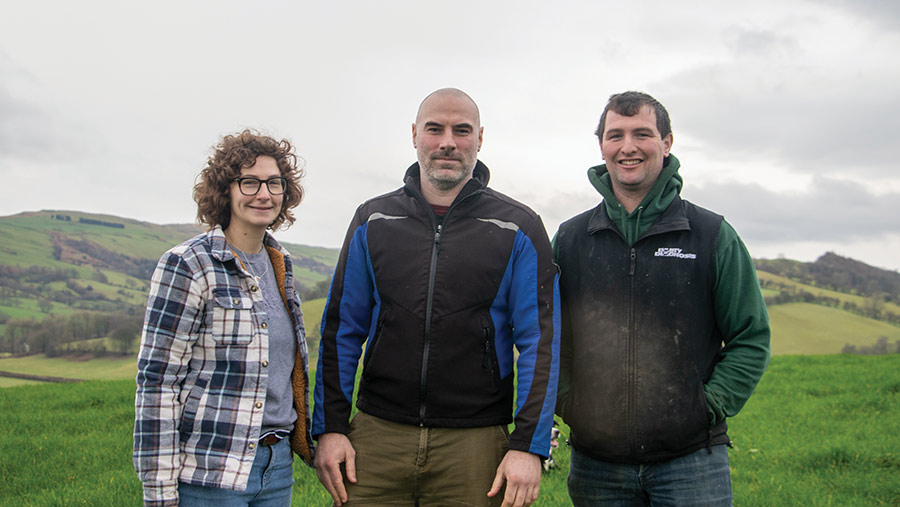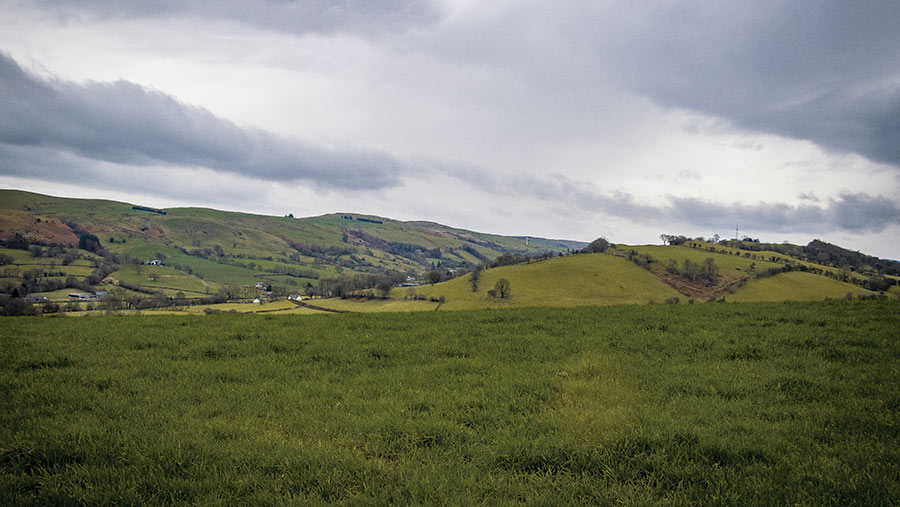How a joint venture helped young couple farm in own right
 Left to right: Siwan Jones, Rhodri Jones, Sion Edwards © Rhian Price
Left to right: Siwan Jones, Rhodri Jones, Sion Edwards © Rhian Price
Two seasons of collaboration with a neighbour gave Rhodri and Siwan Jones the confidence and cash to start dairying on their own.
Rhodri trained as a solicitor and met Siwan, a doctor, in Cardiff, where they both lived before returning to her family farm in Llanerfyl, Powys. After helping Siwan’s parents, Tom and Margaret Jones, run their 1,300 ewes and 130 suckler cows, plans to convert to dairy were crystallised in 2018.
See also: How a new entrant got backing to set up in dairy
Farm facts
Pen Parc Farm, Powys
- Farming in partnership with Siwan’s parents, Tom and Margaret Jones
- Milking 185 cross-bred cows (Friesian cross Jersey) and rearing own heifers
- 67ha owned, with 28ha rented
- Average 4,500 litres at 4.74% butterfat and 3.78% protein in 2023 season
- Calving indoors in a 12-week block from 20 February
- Selling milk to Yew Tree Dairy
- Siwan’s brother, Steffan Jones, and his wife, Rosie, are actors and run a dairy-beef enterprise at the home farm Plas Coch
A trip to the Positive Farmers Conference in Cork the following year with neighbour Richard Tudor inspired the two farming families to join forces.
“Shortly after the trip, Richard’s dad, Tom – who is a first cousin to my dad – suggested we use their parlour and combine labour power,” explains Siwan.
The couple had already invested in a cubicle shed and slurry store. The next big item on the shopping list was a parlour.
“We had been in the process of obtaining parlour quotes. It made sense to share those fixed costs and meant we could invest in grazing infrastructure,” says Rhodri.
Dairy was uncharted territory for the Joneses, so it seemed logical to gain experience from the Tudors, who themselves had recently set up in dairy.
Then the tragic death of Richard in 2020 – just four weeks into the Tudors’ first spring calving season – meant Richard’s son, Morgan, had to step into the driving seat.
The Joneses believe the joint venture, which began the following year, came at a good time to provide support for both families.
The numbers
- 12.5t Grass grown/ha in 2023
- 25% Grazing platform sown in herbal leys
- 80% Cows scanned in-calf in six weeks in 2024
- 97% Heifers scanned in-calf in six weeks in 2024
How the agreement worked
Rhodri – who also works as a farm business consultant – used his knowledge to pen a bespoke agreement.
“Most joint ventures tend to be between a non-farmer and a farmer, but we both wanted to farm.
“We found a way of putting in two sets of cows, labour and land, with a contribution from us for the use of the parlour,” he explains.
To keep things simple, the cows were run as one herd, with one bank account used to pay bills. Labour for each party was accounted for and the Joneses were paid a cow hire fee.
Profit at the end of each year was split 75:25 to take account of the fact the Tudors owned more cows. “Financially, it worked very well for two years for both businesses starting out,” says Rhodri.
The strong milk price of 2022 put the Joneses in a good position to build the final piece of the puzzle – a parlour – and start farming on their own.
“Our families have always been very close and [because of that] we talked openly about an exit strategy, so everyone knew how it was going to work,” recalls Siwan.
“That’s important for joint ventures, especially within families,” adds Rhodri.
When the business was split, the Joneses retained their share of the cows. Any equity they owned in machinery was paid for in heifers.
“As long as the stock is there to do that, it means no cash going out of the business,” says Rhodri. The arrangement was also a good way for them to build cow numbers.
Work-life balance
Rhodri and Siwan are now heading into their second season of milking at Pen Parc Farm, having already started calving. Cows are calving one week earlier this spring, in line with heifers.
“We can turn out, it is dry enough at the end of February and dry off before Christmas to spend time as a family,” says Rhodri, who has two children with Siwan – Rheon, five, and Non, three.
With a young family, Rhodri’s farm consultancy and Siwan working four days as a doctor, they say they could not manage without their herdsperson, Sion Edwards, and part-timer, Tomos Johnston.
Breeding decisions
This season, they will be milking 185, but the plan is to reach 200 cows. The herd is still young – third lactation and younger. Along with the drought last year, this has impacted milk yields.
“Last season, we decided not to feed because the milk price was dropping so fast, but looking back, more feed would have put us in a better position,” says Rhodri.
“This year, we are planning to increase concentrate feed from 750kg to 1.2t a cow and target 5,500 litres.”
Average cow weight (Friesian cross Jersey) is 450kg, and they believe increasing this to 500kg by using Friesian semen, rather than Jersey, will help improve milk yields.
The best cows are artificially inseminated with sexed dairy semen for four weeks, then beef semen is used for a further three weeks before sweeper bulls are turned in.
Limited infrastructure on the heifer grazing block means heifers run with an easy-calving Hereford stock bull.
Cows that score J4-5 for Johne’s are culled, while those scoring J3 are served to beef, along with lame cows, or those with a high cell count (more than 200,000 cells/ml twice in one lactation).
This strict breeding approach is serving them well, with only six cases of mastitis last year and less than 5% lameness.
Grassland management

© Rhian Price
The 65ha (161-acre) grazing platform comprises mainly perennial ryegrass and clover, however, the Joneses have started to reseed with herbal leys to help overcome dry weather.
“Last year, we had seven weeks of no rain in May and June. We are keen to see what the herbal leys add to the mix and if it helps reduce our fertiliser,” says Rhodri.
“We fed silage too late last year and grazed too low because there was nothing else,” adds Sion, who plans to be more responsive this season.
Cows are stocked at 2.95/ha and move to new paddocks on 12-hour breaks.
Future plans
The couple now wants to finesse the system to improve financial performance. “I had no farming background, and I’m very grateful for the confidence Siwan’s parents have shown.
“It was a significant step for them, and with that came pressure,” admits Rhodri.
But the risk is paying dividends, and the joint venture has been a key stepping stone on their journey.
Rhodri and Siwan’s tips on joint ventures
- People are key – you must be compatible and have the same expectations
- Be flexible and open to change
- Get comfortable discussing figures
- Make sure you have an exit strategy agreed
